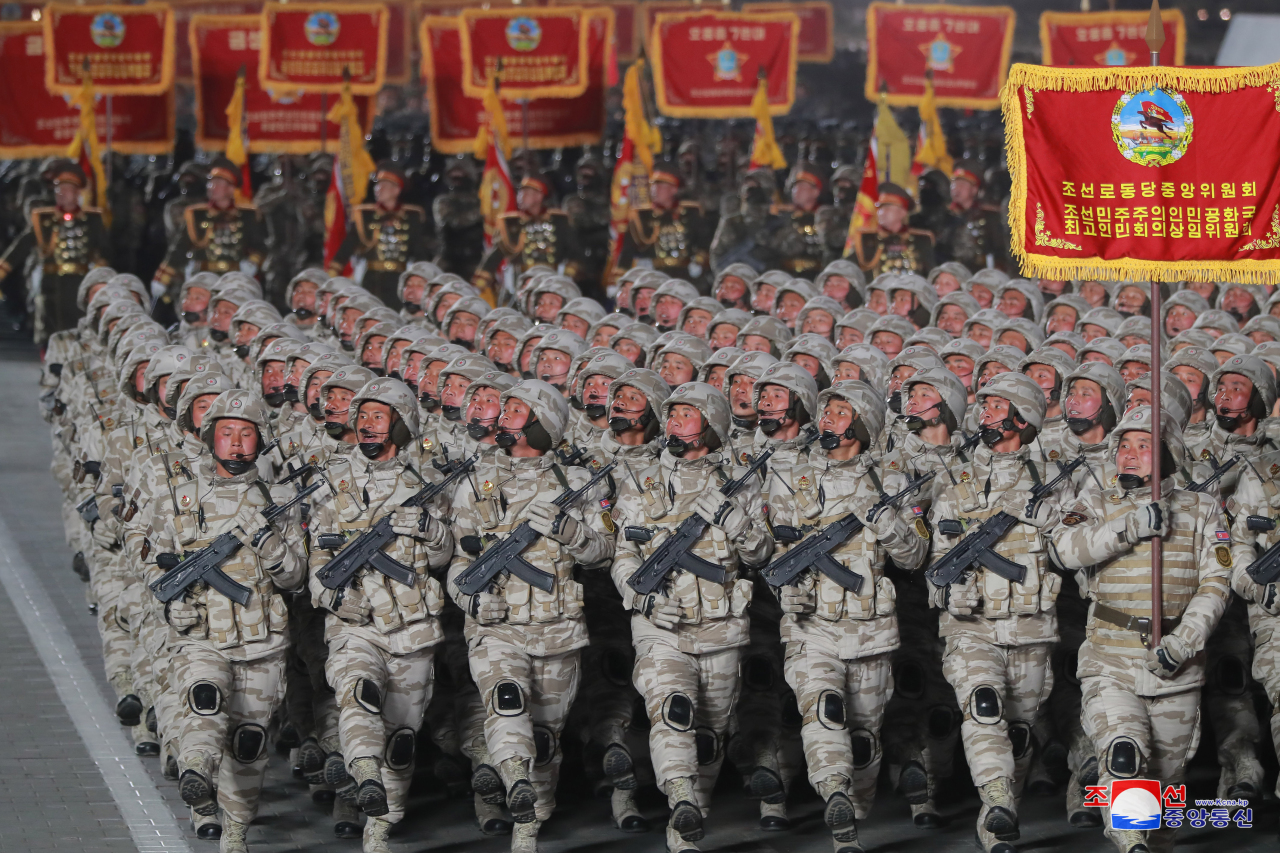 |
North Korean soldiers march during a military parade at Kim Il Sung Square in Pyongyang on the night of Feb. 8, 2023, to mark the 75th founding anniversary of the Korea People`s Army, in this photo released by the North`s official Korean Central News Agency. North Korean leader Kim Jong-un attended it. (Yonhap) |
The Yoon government has decided to bring back the expression in light of North Korea’s antagonistic strategy toward South Korea, its continuing advancement of nuclear capabilities and persisting military provocations against South Korea, the Defense Ministry said Thursday.
“North Korea stipulates its pursuit to communize the entire Korean Peninsula in the rules of the Workers’ Party of Korea revised in 2021 and defines us as an undoubted enemy at the plenary session in December 2022,” read the Korean-language biennial defense white paper for 2022 released the same day.
In that context, North Korea “continues to pose military threats without abandoning nuclear weapons. Therefore, the North Korean regime and the North Korean military, which are the main executors, are our enemy,” the document said.
The “enemy” classification was first mentioned in the 1995 defense white paper in response to Pyongyang’s threat to turn “Seoul into a sea of fire” in 1994, and it was kept until 2000. But Seoul diluted the reference to North Korea and used expressions such as “direct military threat” from 2004 as the two countries made headway in inter-Korean reconciliation efforts.
In 2008, during the Lee Myung-bak administration, North Korea was referred to as a “direct and serious threat.” However, following Pyongyang’s bombardment of the island Yeonpyeongdo and the sinking of the Cheonan corvette in 2010, the expression the “North Korean regime and the North Korean military is the enemy” appeared in the defense white paper published that year. This was maintained until the Park Geun-hye administration.
But in the 2018 and 2020 defense white papers of the Moon Jae-in administration, expressions defining North Korea as an enemy disappeared. It was replaced by “any force that threatens and violates the sovereignty, territory, people and properties.”
The Yoon government’s first defense white paper also specifies an increase in North Korea’s total stock of plutonium for use in nuclear weapons. The South Korean military estimated that North Korea has a plutonium inventory of around 70 kilograms.
North Korea was assessed to have a total plutonium stock of around 50 kg in the defense white papers for 2016, 2018 and 2020.
Around 6 kg of plutonium is generally required to produce one nuclear bomb.
The noteworthy augmentation in plutonium stock is the outcome of previous reprocessing campaigns in 2021 at the radiochemical laboratory located at the Yongbyon Nuclear Research Center, South Korean officials said during a closed-door briefing on Thursday.
Pyongyang can extract plutonium for use in nuclear weapons at the laboratory by reprocessing spent nuclear fuel rods obtained from the 5-megawatt nuclear reactor. The IAEA has said it detected indications of reprocessing at the laboratory from February to July 2021.
Another key feature of the 2022 defense white paper is South Korea’s pledge to forge “future-oriented” security cooperation with Japan despite unresolved challenges.
The paper said, “South Korea and Japan share values and Japan is a close neighbor that (we) seek to establish future-oriented, cooperative relations that serve common interests.”
South Korea’s description of Japan in its defense white papers has changed depending on the twists and turns of bilateral relations. Japan was referred to as a “neighboring country” in 2016 and 2020. Before the current diplomatic freeze, Japan was described as a “geographically and culturally close neighbor and partner with which South Korea must work together for world peace and prosperity” in the paper for 2018.
South Korea’s Defense Ministry explained that the defense white paper has reflected the necessity to increase security cooperation with Japan against escalating missile and nuclear threats from North Korea.
“The South Korean and Japanese defense authorities will enhance cooperation in information sharing while continuing efforts to resolve other remaining issues and improve relations,” the defense white paper read, adding Seoul and Tokyo have “exchanged necessary information” through the legally binding General Security of Military Information Agreement.
The GSOMIA has enabled the two countries to directly share sensitive information since 2016. But both sides need to normalize the military information-sharing agreement, which has not been fully operated since the former Moon Jae-in government’s postponement of the deal’s termination in 2019.
“South Korea will firmly and sternly deal with pending issues, including Japan’s historical distortion and unfair claims of sovereignty over Dokdo islets,” the defense white paper said. “But at the same time, we seek to forge future-oriented cooperation in security issues of common interest for peace and stability on the Korean Peninsula and in Northeast Asia.”







![[Today’s K-pop] Blackpink’s Jennie, Lisa invited to Coachella as solo acts](http://res.heraldm.com/phpwas/restmb_idxmake.php?idx=644&simg=/content/image/2024/11/21/20241121050099_0.jpg)